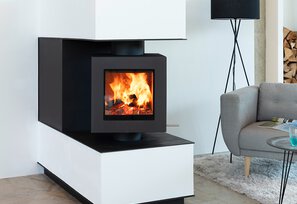Cast iron and steel in fireplace and stove construction
Furnace systems come in a wide variety of designs. The stove body is either made of cast iron or steel sheet with a fireclay lining. Cast iron has always been one of the premium materials. It is the stove construction material with the highest thermal conductivity.

Non-deformable, robust and durable
The main difference to steel is the high proportion of carbon (over two percent), which is why cast iron cannot be shaped or forged, but only cast. It stretches and strains less than steel, less scaling occurs (only at around 800 degrees) and the fits are much more precise. Cast iron is mainly used for components that need to be particularly robust and durable.
Exchangeability of individual parts
In former times, casting small parts was the only economical way to produce clean uniform parts. Steel sheet almost always requires a mechanical effort. Steel sheet fireplaces only became ready for series production and inexpensive to manufacture with CNC machines, but in terms of quality they are not on a par with those made of cast iron. Because the individual parts are screwed onto the sealing surfaces, individual parts of cast iron can also be easily replaced today if necessary.
Resistant even in the greatest heat
Inexpensive devices made of steel sheet are often made of the thinnest possible steel, which saves material costs, but bears the risk that the devices will warp or bulge with prolonged use, or the welds will crack and the doors will no longer close properly. Good steel appliances have an even surface and smoothly ground weld seams. While steel appliances can be damaged by incorrect heating, cast iron is virtually indestructible.

Conclusion
To help you with your decision, the following applies: For systems in which you primarily want to achieve heat rather than atmosphere, cast iron is recommended above all, for example in tiled and storage heaters. In contrast, fireplaces with their large viewing glass faces are typically made of steel.
It should be noted that cast iron takes longer to heat up, but then it also gives off heat for longer. With a steel fireplace it is the other way round. It heats up faster - but also gets cold again faster after operation. It is up to your own needs to decide which material suits you better.











